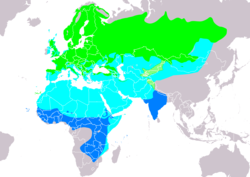| Tree pipit | |
|---|---|
 | |
| At Jamnagar, during wintering | |
| Song, recorded Devon, England | |
| Scientific classification | |
| Domain: | Eukaryota |
| Kingdom: | Animalia |
| Phylum: | Chordata |
| Class: | Aves |
| Order: | Passeriformes |
| Family: | Motacillidae |
| Genus: | Anthus |
| Species: | A. trivialis |
| Binomial name | |
| Anthus trivialis | |
 | |
| Range of A. trivialis Breeding Non-breeding Passage | |
| Synonyms | |
| |
The tree pipit (Anthus trivialis) is a small passerine bird that breeds throughout most of Europe and the Palearctic as far east as the East Siberian Mountains. It is a long-distance migrant, migrating in winter to Africa and southern Asia. The scientific name is from Latin: anthus is the name of a small bird of grasslands, and the specific trivialis means "common".
Contents
- Taxonomy
- Description
- Life cycle
- Distribution and habitat
- Behaviour
- Breeding
- Feeding
- Gallery
- References
- External links
The breeding habitat is open woodland and scrub. The nest is placed on the ground and usually 4–6 eggs are laid. This species is insectivorous like its relatives, but will also eat seeds.











